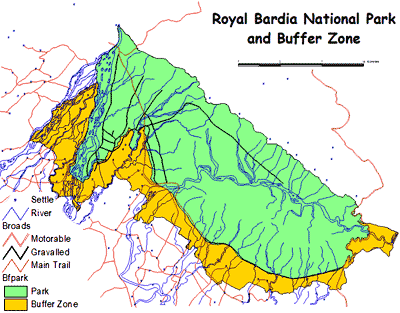 The
Bardia National Park, situated in the
mid-far Western region, is the largest and most
unspoiled wilderness area in the Terai, covering
an area of 968 sq.km. The park, a sub-tropical
jungle, is thickly forested by sal trees and
carpeted with grass, savannah and riverine vegetation.
The north is bordered by the Churia hill range,
the west by the Karnali river, while the Babai
river cuts its course almost through the middle
of the park. On the southern fringe of the park
are the villages of the unique and indigenous
Tharu people of Western Nepal. Considered as
one of the most picturesque national parks in
Asia, it teems with rich and diverse flora and
fauna.
The
Bardia National Park, situated in the
mid-far Western region, is the largest and most
unspoiled wilderness area in the Terai, covering
an area of 968 sq.km. The park, a sub-tropical
jungle, is thickly forested by sal trees and
carpeted with grass, savannah and riverine vegetation.
The north is bordered by the Churia hill range,
the west by the Karnali river, while the Babai
river cuts its course almost through the middle
of the park. On the southern fringe of the park
are the villages of the unique and indigenous
Tharu people of Western Nepal. Considered as
one of the most picturesque national parks in
Asia, it teems with rich and diverse flora and
fauna.
The park is home to more than
30 different mammals, including the langur and
rhesus monkeys, civets, hyenas, wild dogs, sloth
bears, otters, blue bulls, deer and wild boars.
It is a regenerated habitat for endangered animals
like the tiger, rhinoceros, wild elephant (
the park harbours the biggest wild tusker in
Asia) and black buck, Gharial and marsh mugger
crocodiles the great game fish-masher and the
Gangetic dolphin cavort in the river waters.
The unique birds which number over 350 species
include cormorants, egret, storks, geese, jungle
fowls, king-fishers and endangered species such
as the Bengal florican, silver-eared mesia and
the saurus crane thus making the park truly
a bird watchers paradise.
Within the park are several open
grasslands (plants) where game viewing is excellent.
Many of the forest tracks throughout the park
also offer excellent game viewing. And when
you can take in the sights and sounds of the
wild without necessarily having to give up on
your creature comforts, what more could you
ask for…?
CLIMATE
The Park has three distinct seasons, each providing
a unique experience. Form October through early
April the weather is dry. The days are warm,
and the nights are cool and pleasant. From April
to June the temperatures warm up, peaking up
to 450c in May. The hot sticky days give way
to the monsoon rains that lasts until September.
FLORA AND FAUNA
The Park offers a variety of experiences in
its vast undisturbed wilderness. About 70% of
the forest consists of sal trees with a mixture
of grassland and riverine forests. The Park
is home to endangered animals such as the Bengal
tiger, wild elephant, Greater one-horned rhinoceros,
and swamp deer. The other endangered species
include gharial-crocodile, marsh mugger and
Gangetic dolphin. Endangered birds found in
the park are Bengal florican, lesser florican
and sarus crane. More than 30 different mammals,
over 230 species of birds and several species
of snakes, lizard and fish have been recorded
in the park's forest, grassland and river. In
addition to the resident species, several migratory
birds visit the Park,
An elephant ride provides a different
view of the Park as one can go off the main
trail, Morning and late afternoon is the ideal
time to go on a ride. Karnali River is the suitable
home for Gangetic dolphin. Babai valley is a
majestic place to visit where the chances of
sighting of tiger, elephant are high.
BABAI VALLEY AND KARNALI
The Babai valley extending from Parewaodar to
Chepang (bridge) was included in the Park in
1984. The pristine valley is characterized by
rich biodiversity. The major vegetation and
forest type are wooded grassland and the riverine
forest. The translocated rhinoceros from Chitwan
were introduced in this valley. The luxurious
forests in the east of the Park also provide
a good habitat for several wildlife species.
The Karnali River is home to the endangered
Gharial crocodile and marsh mugger. The blue
waters also provide habitat for the endangered
dolphin. Large mahasheer, a game fish, is considered
an excellent catch. The fast flowing water also
provides excellent rafting expeditions that
can stop in the Park. Riverine forests dot the
shores of the river creating prime habitat for
birds such as herons, egrets, blacked necked
stork and the little pratincole.
A stroll through the local villages
will be a rewarding experience. The tharu ethnic
group is native to this area. Traditionally
they are subsistence farmers and practice their
own animistic faith. Handicrafts made by the
community could be brought as souvenirs.
HOW TO GET THERE
You can take a bus from Kathmandu to Nepalgunj
or a flight to Nepalgunj. Buses are available
from here to Amreni. Direct buses are now available
from Kathmandu to Amreni; from where local transportation
is available to Park headquarter.
FACILITIES
A community health centre including a telephone
service is available at Thakurdwara. An information
centre, tharu museum and a captive breeding
centre for crocodile are available for visitors.
There are quite a number of hotels adjacent
to the Park headquarters.